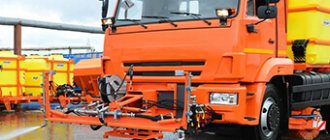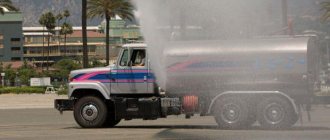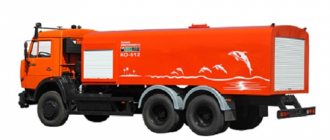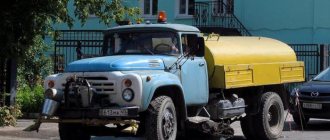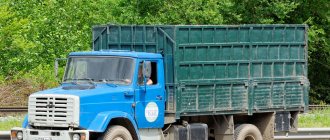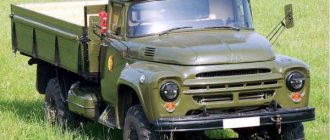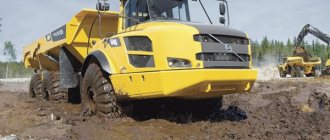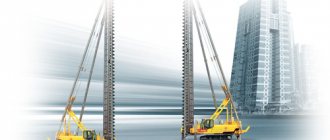Watering machine PM-130B: technical characteristics, device, photo
BSTU named after.
V.G. Shukhova. Department of hoisting and transport and road machines. Coursework in the discipline "Hydraulics and hydraulic pneumatic drive". On the topic: “Modernization of a machine for maintaining roads in the summer. Watering machine." Belgorod 2015. This work reflects general information about watering machines, two patents modernizing working equipment and one patent for modernizing the hydraulic circuit. The graphic part contains a general view of the PM-130 machine on an A3 sheet and a hydraulic diagram on an A3 sheet. 39 pages of explanatory note containing 39 pages.
Brief technical characteristics of the machine PM-130BTank capacity, l..... 6000 Width of the processed strip, m: when washing. . . . . . . ….. up to 8 when watering ….. . . . . . 15…18 Water consumption, l/m2: when washing……………….. 0.8…1 when watering……………..0.2…0.3 Operating speed, km/h: at washing…….. ………..10 when watering…………….. 20Dimensions with watering equipment, mm: length……… …………..6710 width……… ……….. 2420 height……………………. 2350Greatest height of shifted snow, m. . . . .0.5 Width of the processed strip during snow removal, m: plow…………………. 2.5 with a brush……………………. 2.3Transport speed, km/h. . . . . up to 35 Dimensions with plow and brush equipment, mm: length……………………… 7720 width……………….. 3000 height………………….. 2350Basic chassis. . . . . . .. ZIL-13076
Composition: PM-130 general view, hydraulic diagram, PZ
Software: AutoCAD 2015
Manufacturers of watering vehicles
In Russia, the majority of watering vehicles are represented by modifications based on the ZIL chassis. Also, public utility vehicle fleets often maintain equipment based on models from the Kama Automobile Plant. This is a productive and powerful watering machine, which not only makes it possible to service large-volume tanks, but also makes it easier to control the working parts. Gradually, this segment is being replenished by foreign technology. For example, during operation, the Haller 9000 model performs well, which is equipped with a large reservoir and provides the user with ample opportunities for optional equipment.
Watering machine KO-806 based on KamAZ-43253: technical characteristics, device, photo
The city's housing and communal services require a constant supply of new machines and equipment. This is due to the high load that the devices in use experience. Not the last place in this series is occupied by watering machines.
Watering machines KO-806 based on KamAZ 43253
The KO-806 watering machine is produced by the Mtsensk Municipal Engineering Plant. This enterprise was founded in 1956 and is now one of the most technically advanced factories in the country. Products not only satisfy the needs of the domestic market, but are also exported abroad in large volumes.
Watering equipment based on KAMAZ 43253 is a multifunctional machine that is equipped with systems for watering and cleaning roads, for spreading sand and salt mixtures, for servicing sewer and water supply networks, for watering plants and collecting water, and for fire extinguishing.
Model KO-806 has a wide range of applications:
- Watering and washing the roadway.
- Spreading sand-salt mixture.
- Removing snow using a brush and grader.
- Maintenance of pipeline and sewerage systems.
- Firefighting.
- Watering trees, lawns, flower beds.
Device
The watering machine is equipped with a set of equipment to perform a whole range of operations. However, it does have a basic working system. Its main elements are a tank made of metal or a plastic tank. The container inside is divided into several compartments that communicate with each other. Connections are made using pipelines, filters, and pumps. This design is mounted on a KAMAZ chassis. A mandatory requirement for the base is reinforced springs that can withstand the weight of a filled tank.
When water passes inside the tank through the pipeline and filter, it enters the pump. This device creates the necessary pressure, which propels water to the supply pipelines. The machine operates depending on what mode is selected and what equipment is currently installed on the machine.
Photo of the KO-806 watering machine based on KamAZ-43253
Features of operation
Watering equipment based on KAMAZ is designed for operation at temperatures not lower than minus 30 degrees. It is characterized by year-round use. In the summer, using special modes, the KO-806 equipment is capable of watering the roadway with water and sweeping roadsides with a special brush. The large volume of the tank allows you to transport water and water plants, lawns and trees in city parks and squares. The set of special nozzles contains connectors used to extinguish fires, so watering equipment is often at the disposal of fire departments.
Operation in winter consists of the possibility of sweeping the roadway from snowfall, grading roadsides from snow drifts, as well as spreading sand-salt mixture and other anti-icing compounds and substances, including liquid ones.
Having completed a number of simple operations, the watering machine is equipped with a special platform for transporting the removed snow or other materials that have a loose consistency.
Specifications
Technical characteristics of the watering machine based on KamAZ-43253:
General information about watering machines
There are two main types of watering vehicles. Representatives of the first category perform exclusively watering tasks, thus ridding the air and road surfaces of dust. The second group consists of modifications that have an expanded range of devices for washing and cleaning. We can say that this is a watering machine, the list of tasks of which includes caring for road infrastructure. Despite the importance of the irrigation function, this technique is not considered as a separate type. As a rule, these are universal cars, the base of which allows, depending on current needs, the use of one or another functional equipment.
Watering machine MK-6 6000 l: technical characteristics, device, photo
To maintain city streets in proper condition, especially in the summer, when the dustiness of the roads is very high, the city's municipal services use watering equipment. Nowadays, the most common types of watering equipment are truck chassis with the appropriate equipment installed.
Watering machine MK-6 (6000 l)
There are quite a lot of manufacturers of equipment for municipal services, one of which is the Czech company Kobit. Its products include different versions of this type of equipment, including watering machines.
One of the most common models of watering machines produced by Kobit is the MK-6 model.
Purpose, advantages
This machine is intended for washing and cleaning work on road surfaces in city conditions, as well as for watering flower beds and lawns.
There are enough advantages of this machine. The volume of its water tank is one of the most optimal. Water is pumped into the tank either from an external supply - for this, the tank is equipped with a neck for pumping water, or it is possible to pump water using the pump of the machine itself.
In addition to watering the road surface, MK-6 also cleans the surface with a brush. In this case, the road surface is wetted in front of the brush using washout nozzles. There are also side nozzles that can only be used for watering roads or flower beds.
The disadvantages of this technique include only a relatively narrow list of works that this technique performs - only watering and cleaning. In winter, MK-6 is not in demand.
Photo of watering machine MK-6 6000 l
Device
To install the watering equipment, Kobit chose the chassis of the Mercedes-Benz Atego 815. The load capacity of this two-axle truck is completely suitable.
A tank with a capacity of 6000 liters is installed on the frame of the car. For refueling from a source with external water supply, the tank has a large neck at the top. On the right side of the tank there are outlets for connecting pipelines for pumping water using a machine, as well as for watering flower beds without using nozzles. A hose included with the machine is also attached to these outlets.
Story
On October 21, 1962, the Naval flag was raised.
On September 1, 1963, under the command of Captain 3rd Rank V.K. Dragunov and the head of the workshop, Captain 2nd Rank R.G. Likhtman, it became part of the Yokanga naval base of the Northern Fleet. Since 1964, the floating workshop began solving problems related to the repair of submarines. the PM-130 was put into operation
carried out planned tasks and successfully carried out current, navigation and inter-cruise repairs of first diesel and then nuclear submarines.
In 1968, she was awarded a diploma from the commander of the fleet for the best organization of inventive and rationalization work in the fleet.
In 1969, the workshop was awarded 1st place with the presentation of the Challenge Red Banner of the Military Council of the Fleet based on the results of social competition among ship repair workshops. The Komsomol organization of the ship was awarded a diploma from the Central Headquarters of the All-Union campaign of Komsomol members and youth to places of revolutionary, military and labor glory of the Soviet people.
In 1970, the workshop participated in the large-scale Ocean-70 maneuvers. By order of the fleet commander, the title “Excellent Ship” was awarded with the corresponding sign on the wheelhouse, as well as by Resolution of the CPSU Central Committee, the Presidium of the Supreme Council and the Council of Ministers of the USSR No. 238-74, dated April 7, 1970, PM-130
awarded the Lenin Jubilee Certificate of Honor
“For high performance in combat and political training achieved in honor of the 100th anniversary of the birth of V.I. Lenin
.
In 1971, for the first time in the Navy of the Armed Forces of the USSR, the production of inter-cruise repairs of nuclear submarines at dispersed basing points was mastered.
In 1972 PM-130
entered into the Book of Honor of the Northern Fleet, awarded a diploma and a challenge pennant
“For success in socialist competition
.
October 1, 1976 PM-130
reorganized into a floating ship repair plant with the assignment of a new number
PRZ-165
.
In 1997, the PRZ-165
it leaked and the plant lay on the left side.
Watering machine: what is it?
Watering machines were first used several decades ago. From ordinary tanks, water was directed by gravity into special spray nozzles. Thus, this technique was a moisturizing one, not a watering one. However, everything changed in the mid-20s of the last century. It was then that watering machines began to be equipped with fire pumps. Thanks to this, water arrows were sent over quite a serious distance.
Why do you need a watering machine?
Modern watering equipment, which is mounted on trucks, is used to clean city roads. In addition, this technique provides the opportunity to significantly reduce the level of dust in the air.
If you are interested in renting a watering machine from RentSpetsTrans, visit the website rentspectrans.ru
In addition to performing the main functions of cleaning roads with cement concrete and asphalt surfaces, such machines are often used for extinguishing fires, watering green spaces, and transporting water.
As practice shows, it is almost impossible to imagine maintaining highways in the summer without watering devices. And here we are talking not only about dirt and dust penetrating onto the roads from the outside. In summer, the road surface becomes the largest dust generator. During the warm season, the condition of roads is directly affected by air temperature. As a result, the road surface begins to “wear out,” which leads to increased dust formation. Naturally, this dust needs to be removed.
We should not forget that in the road infrastructure there are many structures that need to be cleaned: fences, tunnels, posts next to the road, billboards, road signs, etc. Dust regularly settles on these objects, and accordingly, if you do not take care of them , then they will be covered with a huge layer of dirt.
You won't be able to wash it all off by hand. That is why watering machines are made for such purposes.
Watering machine design
The truck chassis is used as a reliable base. With their help, the rear and front springs are significantly strengthened. In most cases, the car is equipped with flashing lights and an additional headlight.
As for the working equipment of the watering machine, it includes the following elements:
- Mesh filter.
- Tank.
- Water pump.
- Central valve.
- Pipe system with a pair of rotary nozzles.
The most important parts of the hydraulic system are a pump and a tank equipped with a strainer.
The device operates in accordance with the following scheme: liquid from the tank moves through the central valve and strainer and ends up at the centrifugal pump. Subsequently, water under high pressure flows through three-way valves to the nozzles. It is worth noting that the pipeline has several outlets on the sides (to the nuts and to the valve - this makes it possible to connect fire hoses to the watering machine).
The tank is a welded structure made of rolled sheets. It contains various filters, a sump, as well as the main valve. To prevent the water from swinging while the vehicle is moving, special breakwaters are installed in the tank.
The presence of a central valve allows you to control the water supply that enters the pump inlet. At the top of the tank there is a neck that is closed with a lid. It is intended for maintenance and filling the tank with water.
Characteristics
This model is equipped with a central valve with a piping system, strainer and water. Thanks to this design, the vehicles carry out high-quality cleaning of roads and highways, using as little water as possible, which makes renting a watering machine an economically profitable step for the rental company and the private owner. When renting this model, we provide at your disposal cleaning brushes for curbs, a special blade for cleaning roads and sidewalks from snow and dirt, and special equipment for sprinkling roads with salt or sand.
Both enterprises and individuals can order on the ZIL base - (6 m3) in our company. Simply enter into an agreement with us with a list of services and a payment method convenient for you - cash, bank transfer, with or without VAT. Also be prepared to dictate the following information to our operator:
- address of work;
- the weight of the load and the height to which it needs to be lifted (if you order a crane);
- features of the site and entrances to it.
Accurate selection of special equipment is the key to quickly completing work at minimal cost. Our company can offer units for a wide variety of types of work and, if necessary, will send a specialist who will help you decide on the spot which crane or excavator is best to order and how long it will take to complete the task.
Please note: for work in the center of Moscow and within the third transport ring, a special pass is required, and this nuance must also be agreed upon with our representative.
On the ZIL base - (6 m3) for rent from us - a guarantee that everything will be done quickly and efficiently. The key to this is vast experience in operating in Moscow and the Moscow region, a large fleet of special equipment and the well-coordinated work of a team of competent specialists.
Nowadays, special equipment for rent is a guarantee of quick completion of any type of work without purchasing additional machines. Not a single “delicious” order will be missed due to the lack of special equipment - just call us and tell us what needs to be done, and we will select the optimal equipment for this order.
We guarantee a solution to your problems because:
- We have a large fleet of special equipment;
- keep it in perfect condition;
- We work individually with each client.
It is known that even large construction companies do not have to carry out all types of construction and repair work regularly, which means there is no point in purchasing special units for them. What can we say about small businesses that simply cannot afford to buy a large excavator or truck crane. Renting special equipment is a simple and logical solution to the problem.
These guys have the most reasonable prices for such equipment. A couple of times they already took a backhoe loader, leveled the territory, and dug trenches. The equipment works like a charm: it’s quite powerful, it doesn’t stall, it starts with half a turn, the maneuverability is good, it works almost like zero. As clients, we are very pleased with our cooperation with the company.
I ordered this machine to demolish my grandfather’s old house and it did the job more than adequately. I don’t know much about the operation of excavators, especially when this “destroyer” is also attached to them, fortunately here a driver came to our aid, who patiently listened to such incompetents and did an excellent job, the guy turned out to be a good guy, you can talk and joke with him . I was pleased with the work and the people.
For construction, you need a wheeled excavator; it is most convenient to rent it for a while - so I rented a Jcb Js 160w from this company - one of the most practical devices in the construction field. It is extremely easy to use and reliable, increases efficiency on construction sites and speeds up the construction process. The most important advantage is the ease of renting equipment on this service, as well as affordable prices and prompt ordering.
This is not the first time we have used the services of this truck crane. We usually unload various types of slabs for them. The operating speed of the crane is quite satisfactory. It employs an excellent crane operator who copes with the assigned tasks very well. The machine is of a new level, it’s a beast to work with. The rent is quite normal, no matter what. Thank you very much for such a good rental.
We are engaged in construction work, naturally, we constantly need transport. In terms of load capacity and volume, these dump trucks are the most suitable. I am glad that the equipment is in excellent condition, in six months of work we have never had any problems with the machines, they always find a free car for our orders, it is pleasant to work with people.
Renting special equipment turned out to be important and necessary for us. The prices here are quite reasonable, and thanks to the use of the JCB JS 160W wheeled excavator, it was possible to quickly and successfully complete the preparatory work during construction on the site. We are very pleased with this cooperation and will contact you again if necessary.
At a dacha near Moscow they made an individual water supply system. We were digging a well for a pumping station. Manually, of course, this is unbearable, so we ordered this mini-excavator. We chose this company based on a recommendation, but before that we monitored the market for a very long time. The prices were the most reasonable here. And the quality of work is also decent.
We have been ordering the services of this machine for more than several years. All prices are the same as on the website. The car was in good technical condition, no incidents occurred.
This is a very powerful machine. We used it for digging trenches. I really liked the speed of his work. The driver who runs it is a great specialist in his field. Does his job efficiently and quickly. The rental price suited us. The car was in good technical condition, no incidents occurred. If necessary, we will only order here again.
I rented this little thing once, it works without any breakdowns, excellent. Large bucket capacity, as well as level maneuverability and stability. The driver is a polite and understanding man, he and I immediately found a common language, he didn’t mess around and didn’t try to deceive. All prices are the same as on the website.
We are a small construction company. We regularly order the services of this excavator. IT is very stable and most importantly works at good speed. The price per day is quite reasonable. The work he can do in a day is justified by the money. The car is simply powerful. Thanks for such great deals. I confidently recommend this excavator to everyone.
Excellent mini loader, we will order more.
Article rating:
Save to:
Watering machine 6000 l Link to main publication
Watering machine PM-130B
The production of this model began in 1971 at the Mtsensk Municipal Engineering Plant, located in the Oryol region. The ZIL-130 chassis was taken as the basis, which was strengthened for this occasion (more powerful rear and front springs were installed) and equipped with an additional headlight. The unit was produced for a long time, and then was replaced by a new model - KO-002.
The machine was equipped with a tank with a capacity of six cubic meters, as well as a hydraulic pump that creates enough pressure to spray water. In addition, it was equipped with a set of equipment for snow removal - this made it possible to eliminate downtime in the winter and distinguished this model from analogues used before.
Purpose
Utility workers use such machines in the summer to water trees and flowers, wash pavements, refreshing them and clearing them of dust. In winter, a plow located at the front shovels away snow debris, and a rotating brush removes the remaining loose snow and dirt.
In addition, the unit can be used in the construction of irrigation canals, dams and roads. With its help, the soil is moistened.
The best option for public utilities
It is impossible to say for sure which option is better. The machine should be selected based on the specific tasks it has to perform. If the task is to clear snow on the roads, then it is better to give preference to powerful equipment. For this, trucks are usually used, for example KAMAZ, or utility tractors, for example SCOUT TV-804S, to which a blade and a rotary snow blower are connected. If the tasks are wet cleaning, removing garbage, light snow and distributing reagents in a limited urban space, then cleaning machines, for example the domestic PUM-5021, will cope better with this. And for personal plots, the Fighter T-22 mini-tractor is suitable. It is cheaper in cost than utility tractors, but thanks to the ability to connect attachments, it performs the same tasks, only in smaller volumes. In winter it clears the area of snow, and in summer it cultivates the soil, harvests crops and mows hay.
Device
Let's start with the base chassis, which houses a carburetor engine powered by gasoline. Its power is 125 horsepower - part of it is used to operate the brush drive, as well as the operation of the water and gear pumps. To take this power, the vehicle's gearbox and the transfer case attached to it are used. Photo of watering machine PM-130B
Equipment for watering and washing
Inside the welded tank, placed on a frame, there are: a central valve, a sump, a filter and a pipe to control the maximum filling of 5 cubic meters. If it is necessary to increase the volume to 6 cubic meters, the pipe should be increased. The tank is also equipped with breakwaters (two pieces) that prevent the water from splashing too much when moving.
The water pump, attached to the frame rail on the right side, is a single-stage centrifugal pump. It gives a pressure of about 0.35-0.45 megapascals. For spraying, two crevice nozzles with rotating mechanisms are used. If you need to wash the trays, remove the right front nozzle and replace it with a special one.
Snow removal equipment
A snow blade is a curved sheet of steel, rigidly welded to a frame, at the bottom of which there are sectional rubber knives. When worn out, individual sections of knives are replaced. The blade frame is rotary, welded, made in the form of an arc.
The long cylindrical brush, which has its own frame and rotates on bearings, is made from a piece of steel pipe. A hard pile (steel or nylon) is secured to it using a profiled metal tape. A steel rope is bolted to two flanges at the edges of the pipe. By changing its length, you can change the pressure of the brush on the road surface.
Principle of operation
First, water is poured into the tank. This can be done at the refueling point through the top hatch. Other options are also possible: using a hydrant, draw tap water or use a pump (water pump) to pump it from a pond, lake, or river. The latter method is possible thanks to the cylindrical shell, which is equipped with the central valve.
The water in the tank passes through a mesh-type filter to the central valve, and then the centrifugal pump starts working. By pumping up pressure, it forces water through three-way taps and a pipe system to the crevice nozzles. This is how watering or washing occurs. The nozzles can be tilted at different angles to the road surface, and the water pressure can be changed using valves.
In winter, when installing plow equipment and brushes, separate hydraulic cylinders are used to raise and lower them. To rotate the brush, the energy of the car's motor is used, which is transmitted through the selection box, cardan and bevel-type gearbox.
General information
One of the most common types of municipal equipment has been and remains a watering machine. Units of this type have a wide range of applications - from washing roads and watering green spaces to extinguishing fires in case of emergency.
From the very beginning of production, the chassis of the ZIL-130 car began to be used for the installation of road washing equipment. Over the years, several versions of watering machines were produced - KO 002, PM 130 (watering machine), KPM 64 (combined watering machine) and AKPM 3. The tank of watering units was painted orange, the cabin could be of any color (most often sea green). An orange flashing signal was installed on the roof of the cab of later cars.
Irrigation technique
To perform watering, the machine and its working parts must perform several operations, which are controlled by the driver. From the tank, water flows to a centrifugal pump, after which it goes through a filtration stage. The liquid is then directed through a pipeline to the working nozzles. The rest of the work process depends on what capabilities the specific modification of the irrigation machine has. The most modern models have complex systems for distributing liquid between several working sectors. For example, one part may be responsible for watering the road, another for irrigating green spaces, and a third for cleaning the surface.
Chassis
A watering machine based on ZIL-130 was mounted on a chassis with a standard base of 3800 mm. The cars were equipped with a carburetor eight-cylinder engine. With a working volume of just under 6.0 liters, the engine developed 150 hp. With. (with speed limiter). A76 gasoline was used as fuel. The engine was mated to a five-speed gearbox with synchronizers in gears 2-5. The rear wheels were driven by a cardan shaft.
The car's suspension was mounted on semi-elliptical springs, the front beam was equipped with hydraulic shock absorbers. The rear spring consisted of two parts - main and additional. Due to the almost constant load, the springs of the ZIL-130 watering machines were reinforced. The drum brake system was pneumatically driven. The steering was equipped with a hydraulic booster.
The driver's cabin was all-metal with a panoramic windshield. Standard equipment included an adjustable driver's seat, a two-seat passenger seat, a heater with a fan, and a windshield wiper wiper. Additional cabin ventilation could be provided through sliding windows, door windows and hatches in the cabin roof. On early releases there was another ventilation hatch in the area of the clutch pedal. Subsequently, it was removed, and after some time the hatches in the cabin roof were also abandoned.
Mini watering machine
Small watering machines are distinguished by a modest tank volume and corresponding parameters for covering the working area. These models include some modifications of the ZIL with a width of the irrigation area of the order of 2-2.5 m. Also, installations with a sprinkling effect can be included in the category of mini-irrigation machines. They are optimally suited for caring for green spaces and for cleaning road surfaces. True, a watering machine in this design has a very small tank volume, which makes it necessary to frequently fill it with water.
PM-130
This car is one of the most common models of the ZIL-130 watering machine. It began to be produced in 1965 at the municipal engineering plant in the city of Mtsensk. Subsequently, several more enterprises of the USSR mastered the production of the machine.
The capacity of the water tank was 6000 liters. Inside the tank there were breakwaters to increase rigidity and calm fluid vibrations during sudden maneuvers. Water was supplied to the pump from the bottom of the tank through a strainer with a sump. The container was filled with water from the water supply network or with a pump from any reservoir. To control the water level in the tank there were special viewing windows.
To pump water, the machine was equipped with a special centrifugal pump driven by a power take-off (PTO). The pump was mounted on the frame side member, and the PTO was installed directly on the vehicle's gearbox housing. All water supply nodes were interconnected by pipelines. There was a variant version of the machine with an additional tank trailer for 5000 liters of water.
In addition to the water supply system, there was an additional hydraulic system that served to control the brush and plow (during winter operation). For watering and washing, two rotating slot-type nozzles were used, mounted on a subframe in the front of the machine. A subframe with a rotating cylindrical brush for sweeping the road was installed between the bridges. The brush drive was carried out by a chain drive from the power take-off.
“Sweepers” and “water sprinklers”: the history of Soviet municipal vehicles
The responsibilities of this equipment include regular cleaning, washing and cleaning of urban areas, communications and monuments, maintenance and repair of complex electrical, water supply and sewerage systems, garbage and various waste removal at any time of the year and in any climatic zones.
We dedicate this article to the first, simplest and most inconspicuous automobile workers of large Soviet cities, produced before the collapse of the USSR in 1991 - sweeping and watering and washing machines, commonly known as “sweepers” and “polivalki”. They were based on the chassis of ordinary trucks and in those days performed simple duties: sweeping, watering and washing avenues, streets, squares and parks.
The first Soviet sweeper PU-2 on a GAZ-AA chassis on the Garden Ring in Moscow. 1936
First-born sweepers and waterers
The history of Soviet utility vehicles of the sweeping and watering category began in the mid-1930s with the launch of production of one-and-a-half and three-ton vehicles. The design bureau of the Moscow Improvement Administration (UBM), with an eye on similar German vehicles, was the first to create a fairly advanced PU-2 sweeper vehicle on the chassis of a GAZ-AA truck.
Rare use of the PU-2 sweeper in winter in Leningrad
PU-2 machines with side brush covers spaced apart and extended bumpers
Exact information about the design of the PU-2 has not been preserved, but it is known that it was equipped with a wide rear brush and two side brushes, spaced on both sides of the body and providing a fairly wide cleaning strip, which was “protected” from other people’s cars by a wide bumper. Oversized machines, which usually worked at night, turned out to be too heavy and clumsy. In 1938 they were replaced by the “normal” version of the PU-5.
A simplified PU-5 sweeper with an open arrangement of two side brushes. 1938
In 1945-1946, 20 well-known PU-7 “sweepers” with a characteristic pointed front, capable of removing up to 20 thousand cubic meters of pollution per hour, were assembled on its basis.
The most elegant Soviet sweeper PU-7 with side tray brushes. 1946
The PU-7 diagram shows the main rear brush, auger, inclined conveyor and waste bin
From different sides of the GAZ-AA car there were flat brushes for sweeping debris from trays along the sidewalks and a rear round main brush for cleaning the roadway. The garbage they swept away was thrown onto a screw auger and, using a scraper conveyor, fell into a 400-liter garbage container. To avoid dust in the work area, there was a humidification system with forced water supply to the nozzles. All components operated from the chassis power take-off.
An experimental machine designed by NATI on a ZIS-5 chassis with a V-shaped tank, a main brush in the wheelbase and a right-hand brush with an electric drive. 1940
Since 1936, five-ton YaG-4 trucks with characteristic narrow and elongated bumpers, modified by the Moscow Improvement Administration and the Leningrad Cleaning Trust, were used to carry out summer and winter work. They were equipped with water tanks with a capacity of 4 to 5.5 thousand liters, a centrifugal pump driven by a car transmission, two front and two central spray nozzles for cleaning large areas.
On Red Square there is a PM-4 washing machine on a YAG-4 chassis with an increased tank volume and two nozzles. 1936
On Nevsky Prospect, an MPL-4 watering machine with a reduced-capacity tank and two side nozzles
Yaroslavl "sprinklers" PM-4 clear the Garden Ring after the march of German prisoners on July 17, 1944. On the right is the PU-5 vehicle
Since 1939, brushes for washing various objects and snow plows were installed on 59 YAG trucks. In the capital alone, by the beginning of 1941, the fleet of street cleaning machines amounted to 632 units.
PM-4 machine in winter configuration with a rotating blade and drive from the driver’s cabin (from the archive of E. Baturin)
A modernized version of the YAG-6 municipal machine with new washing nozzles. 1940
The rise of the wheeled communal apartment: learning to sweep, wash and water
Already in 1945, work began on previously unknown watering machines with rectangular tanks based on the military-style ZIS-5. In cooperation with other enterprises, the Moscow auto repair shop developed the PM-6 watering vehicle with a tank for three thousand liters of water, a centrally located fire pump and three front nozzles.
Sprinkler PM-6 on a ZIS-5 chassis with three front nozzles and a fire pump. 1945
In Leningrad, MPM-2 “sprinklers” were assembled on two- and three-axle chassis with a front installation of a pumping “organ”, two watering nozzles and four “in reserve”. With the advent of such more advanced technology, work on them was stopped.
Experienced Leningrad watering machines MPM-2 with several types of nozzles and sprinklers
In 1956, at the Experimental Mechanical Plant of the Department of Improvement of the Moscow City Executive Committee, work began on the creation of the first special sweeper vehicle with operating units driven from the GAZ-51 chassis, designed for operation on improved road surfaces. The PU-8 prototype was planned to be equipped with a second steering wheel and duplicate pedals so that the driver could observe the work process from all sides.
Serial street sweeper PU-20 on a GAZ-51 truck chassis
PU-20 machine for working in cities and on improved road surfaces
The working equipment of the serial “sweeper” PU-20 was housed in a streamlined all-welded body and included two flat side brushes (tray or end) and one rear main brush with a chain drive. The tray brushes supplied the sweep to the longitudinal axis of the car. The rear brush threw it onto an auger, from which the garbage was fed onto a conveyor, which delivered it to a bunker with a volume of a thousand liters. To combat dust, a water pump with a filter and a tank for 1000 liters of water was used, which was supplied under pressure to the under-bumper injectors.
The main quick-release working parts of the “sweeper” PU-20 with a chain drive of the main brush
Humidification system with five spray nozzles located under the bumper
The width of the swept strip of the PU-20 machine was 2.7 meters. At full load its weight reached 6.4 tons. The operating speed ranged from 9.5 to 20 km/h, the maximum transport speed was 40 km/h. Gasoline consumption reached 65.5 liters per 100 kilometers.
In the mid-1950s, tests were carried out in Moscow of a fundamentally new “pneumatic” sweeper PUM-2SD on a GAZ-63 (4x4) chassis, modeled after the German Heuser version. Across its entire width, garbage was sucked into the storage hopper without any moisture by a strong air flow. It was not possible to achieve absolute tightness: the noisy and slow-moving vehicle moved in the clouds of a dust storm. Two photos next to each other and a common caption
General view and design diagram of the experimental sweeper PUM-2SD on the GAZ-63 chassis. 1957
Modernized sweeper PU-53 on a GAZ-53-02 truck chassis. 1966
In the 60s, the PU-53 year-round street sweeper appeared on a reinforced GAZ-53-02 dump truck chassis, identical in general design to its predecessor PU-20. Its new products included a hydraulic control system for working bodies, a modernized screw conveyor and two replaceable waste containers instead of one bunker.
Sweeper PU-53 at the exhibition of municipal vehicles at the Exhibition of Economic Achievements of the USSR. 1967 (photo by the author)
The working width of the PU-53 model and the parameters of the water tank have not changed. The capacity of two replaceable hoppers was 1.4 cubic meters, the maximum speed increased to 85 km/h. It was produced by the Experimental Mechanical Plant of the Moscow City Executive Committee and the Kiev Experimental Plant.
In 1966, production of the first Soviet vacuum sweeping machines VPM-53 based on the GAZ-53A began. Their conventional cylindrical brush moved forward under the driver’s cabin and directed the waste onto tray brushes, which threw it into the suction sleeve of the welded intake nozzle of the pneumatic system. The garbage then fell into a vacuum cyclone bunker created by a high-pressure fan. To unload, the all-metal body was tipped back.
Vacuum sweeper VPM-53 with main and tray brushes and a suction hose. Photo from 1974
The useful capacity of the VPM-53 machine’s bunker was 1.6 cubic meters, the maximum estimated weight was two tons, and the water supply was 760 liters. Operating speeds – from 5 to 16.5 km/h. The total weight of the vehicle is 6.6 tons.
The second, no less extensive, group of watering machines consisted of fairly simple “sprinklers”, created on the basis of serial trucks and designed for watering and washing road surfaces using powerful flat fan-shaped water jets.
The first experimental “sprinkler” in 1955 was the PM-8 machine on a ZIS-150 truck with a closed all-metal body, the work on which was implemented in the design of almost all subsequent vehicles of this category. Two years later, the UBM Design Bureau created a modernized version of the PM-10 for installation on ZIS-150 and ZIL-164 trucks.
Sprinkler PM-10 with front and central nozzles near the theater of the Soviet Army. 1957
Watering machines PM-10 on ZIS-150 chassis with front washing nozzles
The equipment of this machine consisted of a tank with a capacity of six thousand liters, mounted on a spar frame, a single-stage centrifugal pump with filters and a discharge pipeline. From them, water under pressure was supplied to two under-bumper nozzles, but on a number of cars a third nozzle was mounted on the right side under the body. In winter, the P-11 snow removal kit was installed on the PM-10 machine.
Watering machine PM-10 on the chassis of a ZIL-164 truck. 1959
The width of the irrigation strip was 18 meters, in washing mode - seven meters. The dry weight of the PM-10 machine is 5.5 tons, with a full load - 11.5 tons. Operating speeds were within the range of 16-20 km/h.
At the same time, a heavy watering machine PM-9 with a tank for 7.5 thousand liters of water appeared on the chassis of the MAZ-200 truck, and an entire PMP road train with a reserve of seven thousand liters was built in Leningrad.
Leningrad watering road train PMP with a ZIS-120N truck tractor and a tank semi-trailer. 1956
With the advent of ZIL-130 trucks, on their basis, various enterprises assembled PM-130 watering and washing machines with a cardan drive from the power take-off box of a centrifugal single-stage pump mounted on the right side member of the vehicle frame. Unlike the first PM-10 vehicles with decorative body cladding, a welded oval tank of the same capacity with a front water intake hatch, two breakwaters and a device for determining the water level was exposed here for the first time. On both sides there were cases for sleeves and sets of nozzles, and a spotlight was mounted on the roof of the cabin for work at night.
Universal machine PM-130 on a ZIL-130 chassis with front nozzles and a washing brush. 1970s
Depending on the climatic conditions, various brushes driven by the base chassis were mounted under the car frame. Thanks to the hinged mount, the nozzles were installed at any angle, and the driver from the cab could adjust the direction and force of the jet.
Since the second half of the 70s, the most common Soviet “sprinkler” was the PM-130B variant, the modernization of which concerned only minor components.
Modernized watering machine PM-130B on a ZIL-130-76 truck. 1980
For these machines, the width of the treated strip when watering was 15-18 meters, when washing – 7-8. The total weight with water and special equipment reached 11.5 tons, the operating speed was 10-20 km/h. During the entire production period, their own weight of 5.5 tons remained unchanged.
Combined watering machine KPM-3 with three powerful nozzles and a summer brush
Little-known combined watering machines of several models based on ZIL-130 (KPM-64, KPM-3, KDM-130/130A, etc.) were used in highway maintenance services, equipped with replaceable custom-made equipment and flashing lights, differing in details and a number of parameters and were exported. In different configurations their weight was 5.2-5.8 tons.
Communal "watering stations" of the recent past
None of the utility vehicles described here have survived to this day, but they have left new, distinct offspring. Here we will limit ourselves only to special vehicles that were assembled under the general index KO (municipal equipment) and were produced before the collapse of the USSR.
Sweeping machine KO-304 on a GAZ-53A chassis for processing trays and pneumatically feeding waste into a tilting hopper body. 1978
Sweeping machine KO-309 based on GAZ-53-14 with a pneumomechanical pick-up and a flexible hose with a vacuum cleaner tip. 1987
Watering machine KO-002 on a ZIL-431416 chassis with a tank for 6.2 thousand liters of water with hydraulic and sweeping equipment. 1987
A unique multi-purpose road maintenance vehicle ED-244 on a MAZ-5337 truck with a tank capacity of 7.5 thousand liters, a metal body and a blade. 1988
The title photo shows the first Soviet PU-2 street sweepers on a GAZ-AA chassis on night duty on the Moscow Garden Ring.
The article uses only authentic black and white illustrations
KO-002
The production of the previous version of the ZIL-130 watering machine lasted about 20 years. Only in the mid-80s was it replaced by the modernized version KO-002. The car was produced at the same plant in Mtsensk. The operating principle and design of the main components and assemblies have not changed.
The main difference was the improvement in the technical characteristics of the ZIL-130 watering machine: an increase in the capacity of the main tank by 200 liters and the width of the coverage area when washing and watering. The operational speed when performing work has also increased slightly. This machine was the last highly specialized washing machine. All subsequent models of municipal units were equipped with a replaceable set of equipment - for the winter period, the tank was replaced by a module for dispersing the sand-salt mixture.
